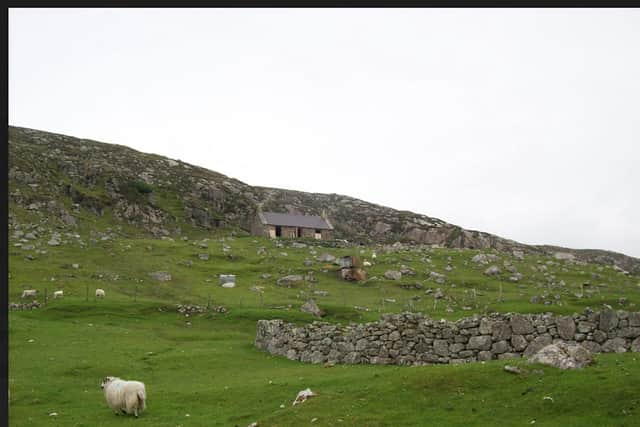The Scottish island that everyone left and an abandoned house now sold as a second home
This week marks the anniversary of the last permanent resident leaving Scarp, which sits half a mile over the water from Hushinish in Harris. The departure of Mr and Mrs Angus MacInnes and their two sons on December 2, 1971 marked the end of an era on an island once home to more than 200 people in the late 19th century.
Today, Scarp is owned by Anderson Duke Bakewell, an American musicologist and founder of the Isle of Harris Distillery, who described the island as his “spiritual home”, which he first visited in the early 1960s when a few families still remained. Today, visitors walk among the abandoned remains of their homes with the Scarpachs recorded as having a well-developed sense of humour, a deep spirituality and a largely self-sufficient life underpinned by spinning, fishing and growing of barley and potatoes. Much of their income came from lobsters sold at Billingsgate Market in London.
Advertisement
Hide AdAdvertisement
Hide AdIslanders ran their own parliament, with men gathering each morning to make plans for any task requiring a communal effort. Any visitor to Scarp had to signal or shout across the Sound of Harris to advise the islanders of their presence with a boat then sent for them. There were no surprise house calls here.
Now, this relative seclusion is a property seller’s dream, with the island described as a “remote and majestic sanctuary” last year as Primrose Cottage, one of the few habitable properties on Scarp, was put up for sale by Mr Bakewell. With no waste water system and electricity coming from a generator, the property was described as a “fantastic bolt-hole opportunity for someone looking to escape city life and re-charge in nature”.
The title also restricts the owner from using the cottage for tourism or holidaymakers in any way.
Primrose Cottage, which attracted a high level of interest and went to a closing date almost immediately, was marketed for offers over £100,000, but the final sale price hasn’t been disclosed.


The cottage was once home to Mrs Duncan, wife of schoolmaster William Duncan, who ran the island school. Their son was Rev Angus Duncan, who published Hebridean Island: Memories of Scarp in the 1940s. The minister, who served during World War One, was born on Scarp in 1888 and left when he was 14 to study at Inverness Royal Academy.
A critique of the book said: “The author's father taught classes consisting of married men as well as children and as the school had existed since 1821, it is obvious that education must often have taken second place to croft work and fishing. Many of the older people in the early years of the present century could not read. In spite of this, the reader gains a strong impression of a people who were perceptive and were possessed of highly retentive minds.”
In 1971, newspaper reports documented the exit of the MacInnes family who settled on a croft at Govig in Harris.


The article, printed in the Press and Journal, said Scarp was then “left to the Old Etonians” given its remaining residents were Andrew Miller Mundy, whose father once owned the North Harris Estate, and his school friend Andrew Cox, who temporarily moved to the island earlier that year with his wife and their baby. They held on for several more weeks until a heavy storm cut the island off, with provisions running ‘dangerously low’.
Advertisement
Hide AdAdvertisement
Hide AdMundy, in London at the time, sent a helicopter in to rescue his girlfriend, with food also flown into Scarp. He later lived permanently on Harris, trained himself to catch lobsters and worked the waters around St Kilda for a decade. He became a popular figure to many, representing Harris at council level for many years and was admired for his dedication to wildlife and conservation.
The stern storms and lack of a sheltered harbour were an enduring challenge for Scarpachs over generations. Although a jetty is now in place, fishermen had to wade up to their waist to launch their boats each morning and remain soaked and freezing for the rest of the day.
The island population peaked in 1881 when 213 people lived on Scarp, with the numbers swelling following clearances on Harris. The population was impossible to sustain with pleas made to the Napier Commission, the inquiry into conditions for crofters in the Highlands and Islands, to allow resettlement on Harris.


Despite a suggestion from factor Kenneth Macdonald that emigration may be a better option, several Scarp families were allocated crofts in the 1880s. According to research by Jill Harden for the Isle of Harris online guide, more than 25 families eked out an existence on Scarp until after World War One.
The trials of island life were highlighted in January 1934 when islander Christina Maclennan gave birth to her first twin, Mary, on Scarp with the help of an untrained midwife. Amid complications, she was taken to Harris by boat and then, lying on the floor of a bus, moved to Stornoway where she gave birth to her second daughter, Jessie, two days later.
The case was raised in the House of Commons by National Liberal MP Thomas Ramsay, who called for a properly trained nurse, a pier and new roads for Scarp.
That year, the island became the setting of a bizarre trial of the Western Isles Rocket Post when German scientist Gerhard Zucker arrived to test out his mail delivery system. Said to have been inspired by Ms Maclennan’s dramatic labour and fuelled by a desire to “bring the world together”, he tried to send a rocket packed with 4,000 letters over to Harris.
The mission failed with a dull explosion and a cloud of smoke – but life on Scarp was illuminated once again.
Comments
Want to join the conversation? Please or to comment on this article.